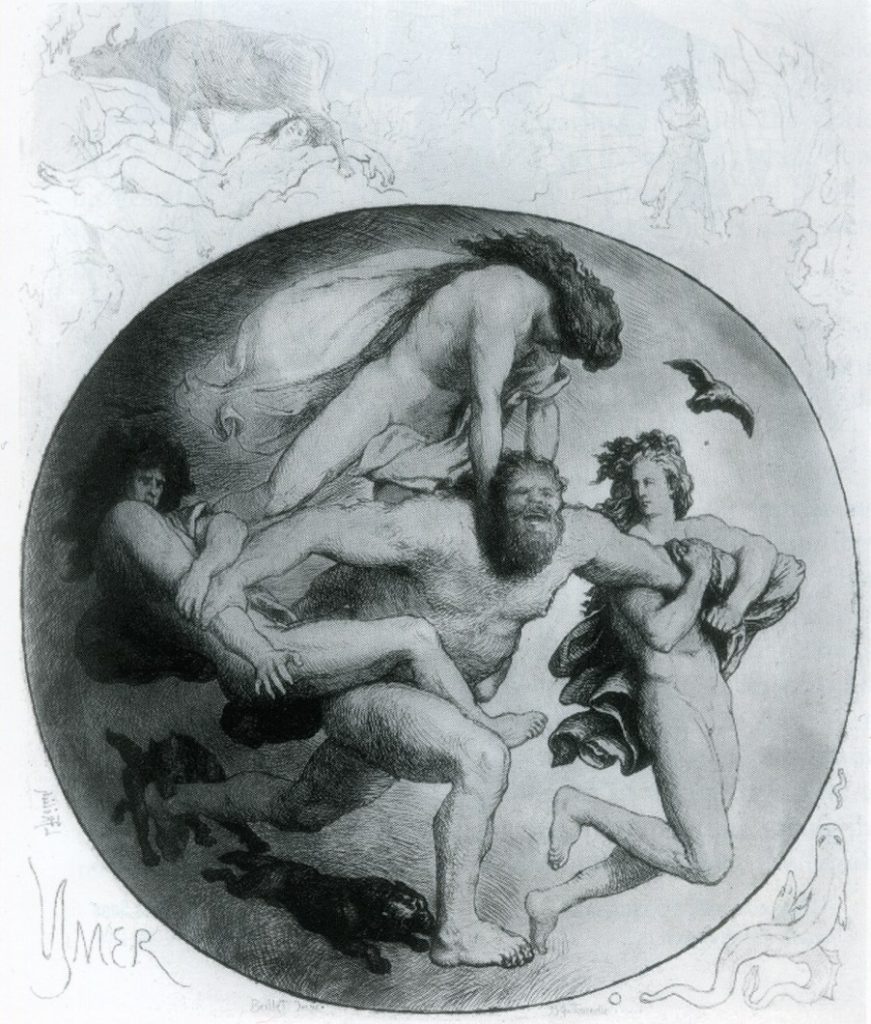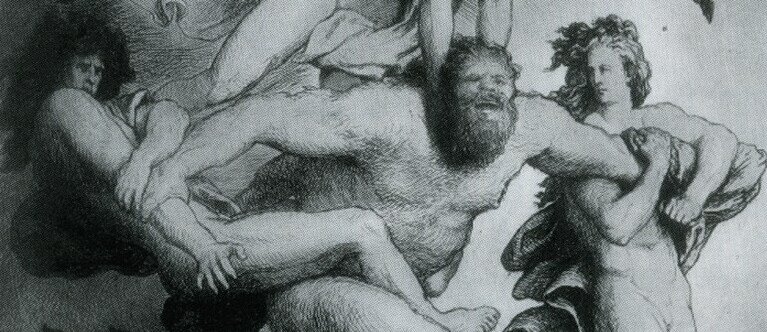In Norse mythology, Ymir is the ancestor of all giants (jotnar). Ymir is also known to the frost giants as Aurgelmir, the oldest and strongest frost giant ever to exist.
In Norse mythology, Ymir is not only the first giant in existence but also the very first being. In the Norse creation myth, Ymir or Aurgelmir is the being from which all the Æsir gods descended. He is also the ancestor of all Vikings.
Without Ymir, the Scandinavian myths and legends of the Norse gods would not exist.
Is Ymir a god?
While Ymir is the first being created and the ancestor of all life, he is not technically a Norse god. Ymir is considered the primordial giant from which all giants were spawned. Ymir is neither male nor female but often referred to as “he” in texts and depicted in masculine form in artwork.
Ymir was a hermaphrodite who birthed a male and female child from the sweat under each armpit while asleep. From his legs, he birthed a six-headed son.
Because all Norse gods at least partly descended from giants, Ymir is also considered the ancestor of all the gods.
Does Ymir symbolize evil Norse mythology?
Ymir is not only considered a symbol of evil in Norse mythology but the very embodiment of evil and destruction.
The giant Ymir arose from the chaos and is said to have sprung from poisonous elements. By his very nature, Ymir was brutal and ruthless. Driven by instinct and desire, Ymir didn’t have a merciful bone in his body.
In Norse mythology, giants are considered bad, troublesome creatures. Since all giants come from Ymir, Ymir is believed to be the cause of their evil nature.
Who gave birth to Ymir?
Ymir is the first being to exist, which means no one gave birth to Ymir. According to Snorri Sturluson’s the Prose Edda, Ymir sprang forth for the poison created when Niflheim and Muspelheim crashed together. Their elements of fire and ice merged into the void between the two–called Ginnungagap–creating the frost giant Ymir.
Muspell (Muspelheim) was a land of heat and flame. Across the void Ginnungagap, Niflheim sat frozen and silent. One day, the heat of Muspelheim and the ice of Niflheim combined, creating molten ice called rime. The resulting drops from the mixing elements formed into the shape of a man, and Ymir were born.
Following the appearance of Ymir, the rime created another being. This being was a primordial cow called Audhumla. Audhumla licked the rime blocks, nourishing herself so her udder would fill.
From her udder sprang four rivers of milk, which Ymir fed from. While Ymir fed, Audhumla continued to lick the rime for three days straight until she revealed Buri, the first of the Æsir gods.
Is Odin a descendant of Ymir?
The Norse god Odin is a descendant of Ymir by way of the giantess Bestla.
Odin is also a descendant of the god Buri, revealed from the rime by the cow Audhumla. The Norse god Buri had a son named Bor (Borr), who married the giantess Bestla.
Bor and Bestla had three sons–Odin, Vili, and Vé. Very little is known about Vili and Vé, but their brother Odin went on to become the most powerful god of Asgard. Later, the three brothers would work together to defeat Ymir.
How did Ymir die?
The brothers Odin, Vili, and Vé killed Ymir.
As time passed, Ymir became more evil and vile, but his savagery was not the sole reason for his death. Ymir was killed so that Odin could create the world. So the three brothers banded together, hunting the frost giant and killing him to bring order to the chaotic realms.
It was Odin’s spear that spilled the blood of Ymir, which flooded the realm. The flood killed all the frost giants, all except Bergelmir.
Bergelmir used a hollowed-out tree to survive the flood, bringing his family with him. Bergelmir and his wife repopulated the race of giants, also known as jötnar.
The survival of Bergelmir and his descendants concerned Odin. According to the Prose Edda, Odin was worried the descendants of Bergelmir–and by ancestry, Ymir–would someday avenge Ymir’s death.
While this particular fear never came to fruition, another descendant of giants, Loki, would kill Odin’s beloved son Baldr. Baldr’s death would set into motion the events leading to the end of the world known as Ragnarök.

Ymir’s body and the creation of the world
The Norse god Odin used the body of Ymir to create the earth, the oceans, and the sky.
Odin’s use of Ymir’s body is recounted in stanzas 40 and 41 of the poem Grimnismal. This poem and other poetic accounts of Norse mythology are contained within the pages of the Poetic Edda.
When Ymir was conquered by the god Odin, Odin used the pieces of Ymir’s body to create the world. Even the maggots from his rotting flesh became the four dwarves who held up the sky and represent the four directions.
According to the poem Grimnismal, translated from Icelandic, each piece of Ymir’s body became an element of creation:
Of Ymir’s flesh
was earth created,
of his blood the sea,
of his bones the hills,
of his hair trees and plants,
of Ymir’s skull the heavenand of his brows
Grimnismal – Germanic Mythology
the gentle powers
formed Midgard for the sons of men;
but of Ymir’s brain
the heavy clouds are
all created.
From an ancient being of chaos, the god Odin created the entire world, connecting the mortal world to Asgard using Ymir’s own eyelashes. While the Old Norse creation myth is fraught with danger and destruction, beauty and life were formed from the body of evil incarnate.
As the father of all giants, the first being to ever exist, Ymir’s story is the very foundation of the rich legends of Norse mythology.

